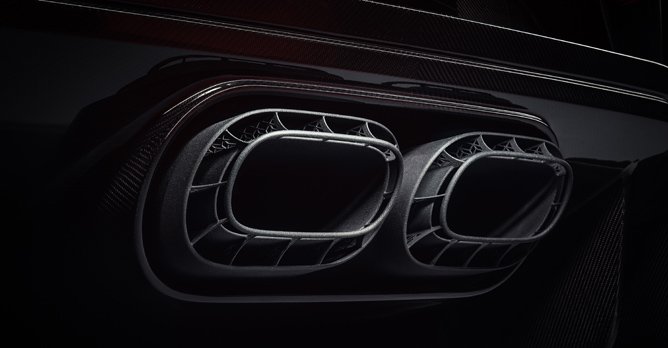Bugatti develops innovative 3D printing technology
27 Mar 2020|687 views
Bugatti is the only company in the automotive industry to use 3D printing to produce tailpipe trim covers made of titanium for its newly developed Chiron Pur Sport and the Chiron Super Sport 300+.
The cover is the first visible part to be 3D-printed in metal that is officially approved for use on the roads.
The trim cover at the rear of the Chiron Pur Sport weighs just 1.85kg including grille and bracket, 1.2kg less than the cover on the Chiron. Four 400W lasers simultaneously print titanium to produce the component.
The wall thickness at the thinnest point is just 0.4mm, yet the filigree cover is still able to withstand temperatures of over 650°C thanks to its double-layered outer wall for thermal insulation.
In this way, the cover protects surrounding components from excessive heat dissipation under full engine load. At the same time, fresh air around the cover cools the component.
This is not the first time that Bugatti has developed components using 3D printing. The engineers have been producing this special trim cover for the Chiron Sport and Divo since 2018. The 2019 editions 'La Voiture Noire', the ultimate Grand Tourisme for Bugatti enthusiasts, and the Centodieci, a reinterpretation of the EB110, also make use of this printed component.
The material Inconel 718, used in aerospace applications where aluminium would melt, is a heat-resistant, hard and light nickel-chrome alloy. It is used to produce a 53cm wide and 22cm long trim cover for the Chiron Sport.
The trim cover of the Chiron Sport covers four tailpipes of the six-branch exhaust system at the rear, offering not just visual benefits but technical advantages too. With its large and sturdy tubes, it helps conduct hot exhaust gases away from the rear to lessen heat accumulation. It's also lightweight at 2.2kg, 800g less than a normal cover.
Bugatti is the only company in the automotive industry to use 3D printing to produce tailpipe trim covers made of titanium for its newly developed Chiron Pur Sport and the Chiron Super Sport 300+.
The cover is the first visible part to be 3D-printed in metal that is officially approved for use on the roads.
The trim cover at the rear of the Chiron Pur Sport weighs just 1.85kg including grille and bracket, 1.2kg less than the cover on the Chiron. Four 400W lasers simultaneously print titanium to produce the component.
The wall thickness at the thinnest point is just 0.4mm, yet the filigree cover is still able to withstand temperatures of over 650°C thanks to its double-layered outer wall for thermal insulation.
In this way, the cover protects surrounding components from excessive heat dissipation under full engine load. At the same time, fresh air around the cover cools the component.
This is not the first time that Bugatti has developed components using 3D printing. The engineers have been producing this special trim cover for the Chiron Sport and Divo since 2018. The 2019 editions 'La Voiture Noire', the ultimate Grand Tourisme for Bugatti enthusiasts, and the Centodieci, a reinterpretation of the EB110, also make use of this printed component.
The material Inconel 718, used in aerospace applications where aluminium would melt, is a heat-resistant, hard and light nickel-chrome alloy. It is used to produce a 53cm wide and 22cm long trim cover for the Chiron Sport.
The trim cover of the Chiron Sport covers four tailpipes of the six-branch exhaust system at the rear, offering not just visual benefits but technical advantages too. With its large and sturdy tubes, it helps conduct hot exhaust gases away from the rear to lessen heat accumulation. It's also lightweight at 2.2kg, 800g less than a normal cover.
Latest COE Prices
September 2025 | 2nd BIDDING
NEXT TENDER: 08 Oct 2025
CAT A$119,003
CAT B$136,890
CAT C$72,501
CAT E$140,502
View Full Results Thank You For Your Subscription.
























